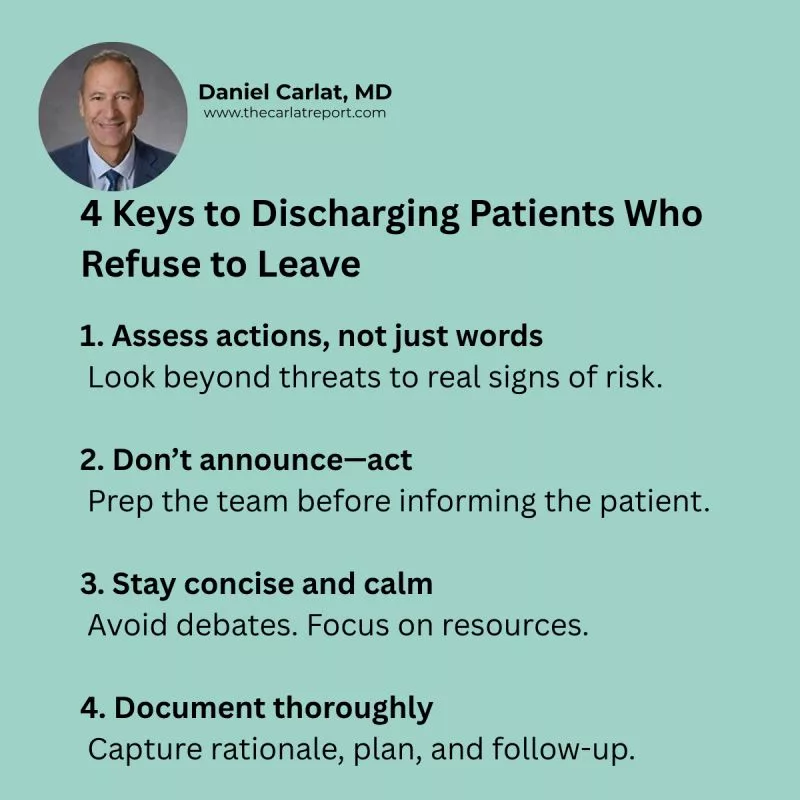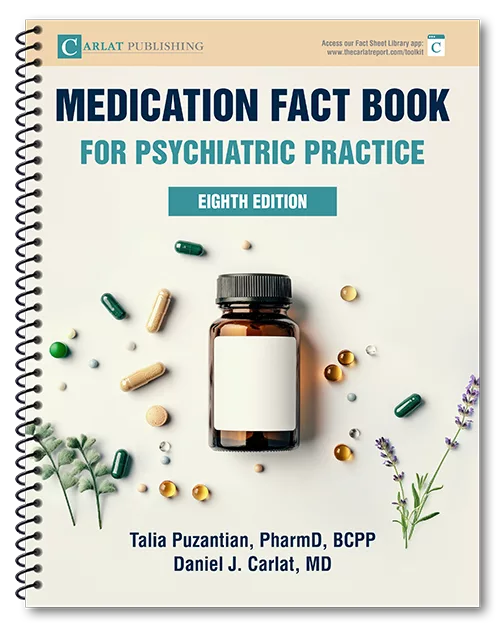4 Keys to Discharging Patients Who Refuse To Leave

“If You Discharge Me, I’ll Kill Myself!”
It’s one of the most gut-wrenching statements a psychiatrist can hear—and one of the most misused.
We’ve all been there: a patient who no longer meets criteria for inpatient care, but who refuses to leave. Sometimes it’s malingering, sometimes a deeper trauma pattern—but either way, beds are blocked, teams are exhausted, and care is compromised.
Why It Matters
Administrative discharges are rare but essential. Used thoughtfully, they protect resources, reduce iatrogenic harm, and deter dysfunctional behaviors—without abandoning the patient.
Here’s what we know:
- Common profiles: deceptive (malingering, factitious disorder) or disruptive behavior
- Risk assessment is key—don’t let threats cloud judgment
- Prepare the team, not the patient, in advance of the discharge
- Keep the “exit conversation” brief, clear, and compassionate
- Always include referrals—and security
- Document everything, and debrief the team
4 Keys to Discharging Patients who Refuse to Leave
- Assess Actions, not just words: Look beyond threats to real signs of risk
- Don't announce—act: Prep the team before informing the patient
- Stay concise and calm: Avoid debates, focus on resources.
- Document thoroughly: Capture rationale, plan, and follow-up
Reframe
Administrative discharges aren't punitive—they’re therapeutic when done well. They can help patients pivot toward real-world resources and discourage hospital-dependence. But biases creep in easily. Slower decisions, second looks, and transparent processes are critical for equity.
Takeaway
If inpatient units are our ICUs, we have to treat capacity like oxygen. Holding patients “just in case” feels safe—but it can quietly erode access and outcomes for everyone.
Discussion Prompt
- Have you ever struggled with a discharge that didn’t feel “clean”? What helped guide your decision?
- Share to support nuanced conversations about safety, equity, and real-world care.
- Join the conversation on LinkedIn with Dr. Carlat
- Follow me (Daniel Carlat) for practical, no-fluff updates from the frontlines of hospital psychiatry.
Related Materials
- Exit Strategy: Discharging Patients Who Resist Leaving
Article by Victoria Hendrick, MD - Factitious Disorder: Navigating the Challenges of Deceptive Illnesses
Article by Jonathan Heinzman, MD and Michael A. Strong, MD, MSEd -
Understanding Suicide Prevention and Intervention Strategies
Expert Q&A with J. John Mann, MD -
Psychiatric Medication-Induced Hyperprolactinemia
Podcast Episode with Victoria Hendrick, MD and Prabhjot Gill -
Hospital Psychiatry Fact Book, First Edition (2025)
by Victoria Hendrick, MD and Daniel Carlat, MD
Newsletters
Please see our Terms and Conditions, Privacy Policy, Subscription Agreement, Use of Cookies, and Hardware/Software Requirements to view our website.
© 2025 Carlat Publishing, LLC and Affiliates, All Rights Reserved.

_-The-Breakthrough-Antipsychotic-That-Could-Change-Everything.webp?t=1729528747)



